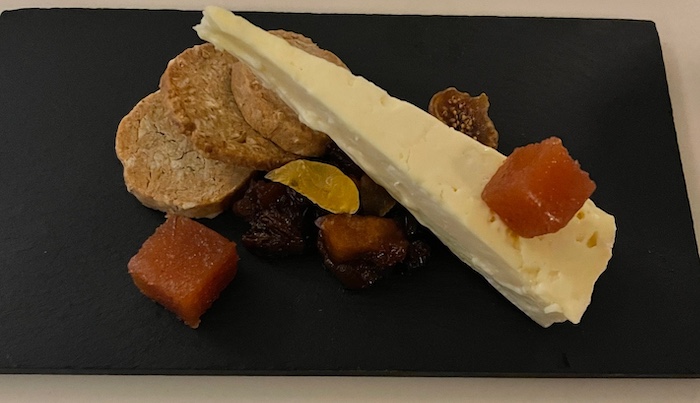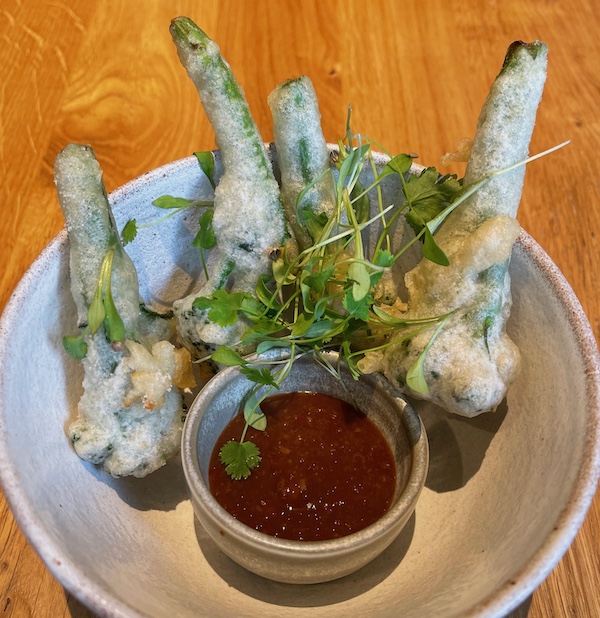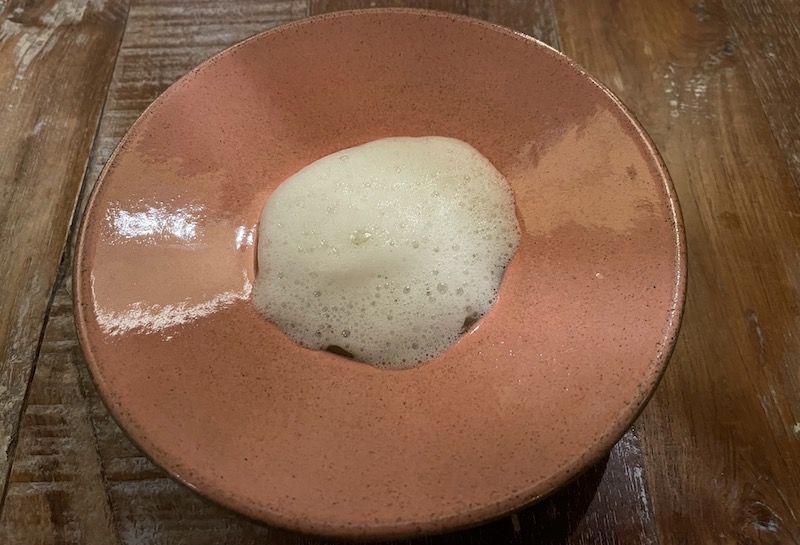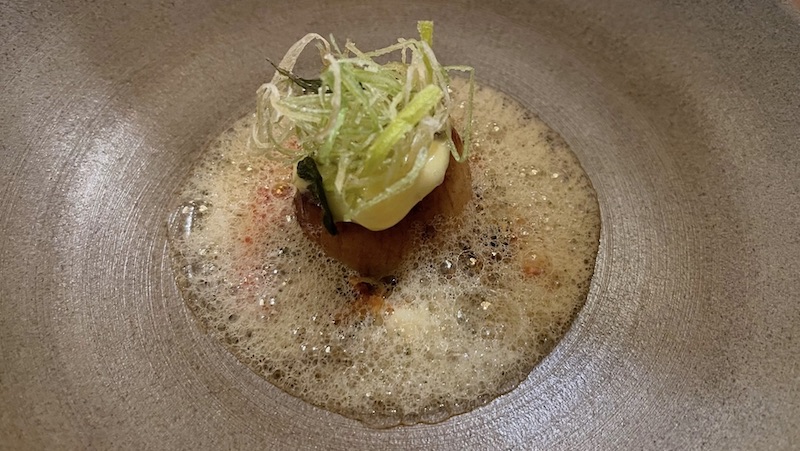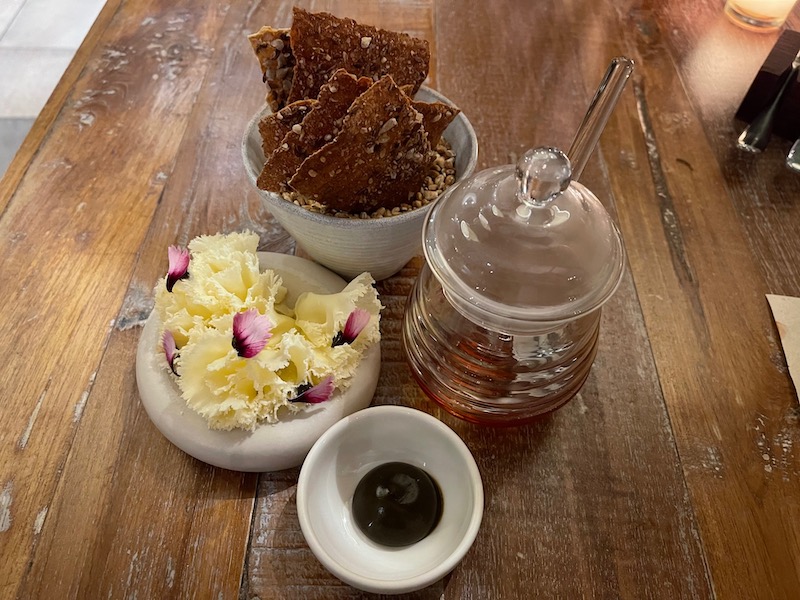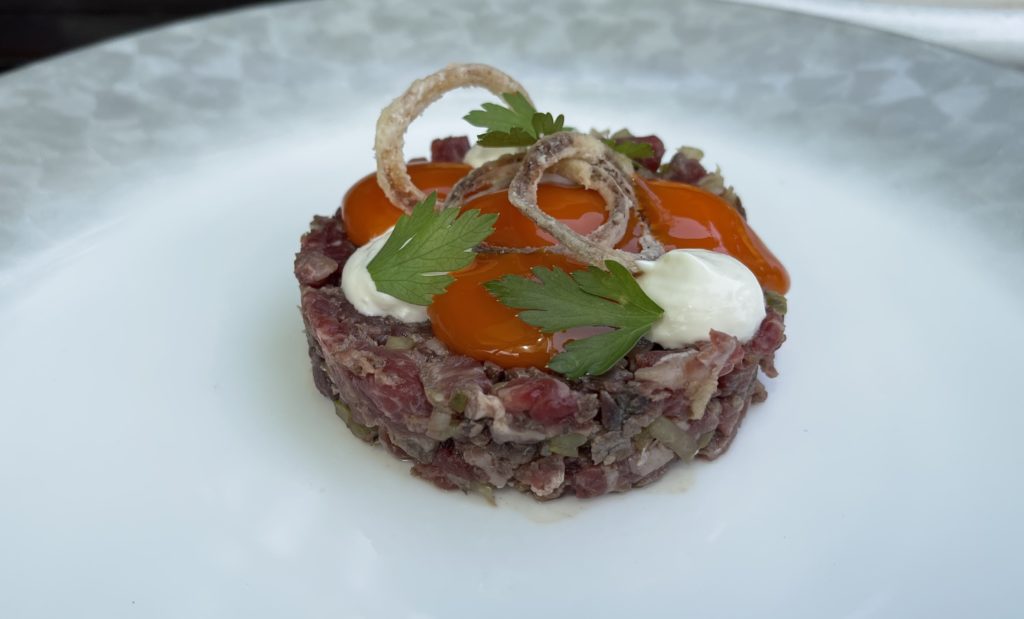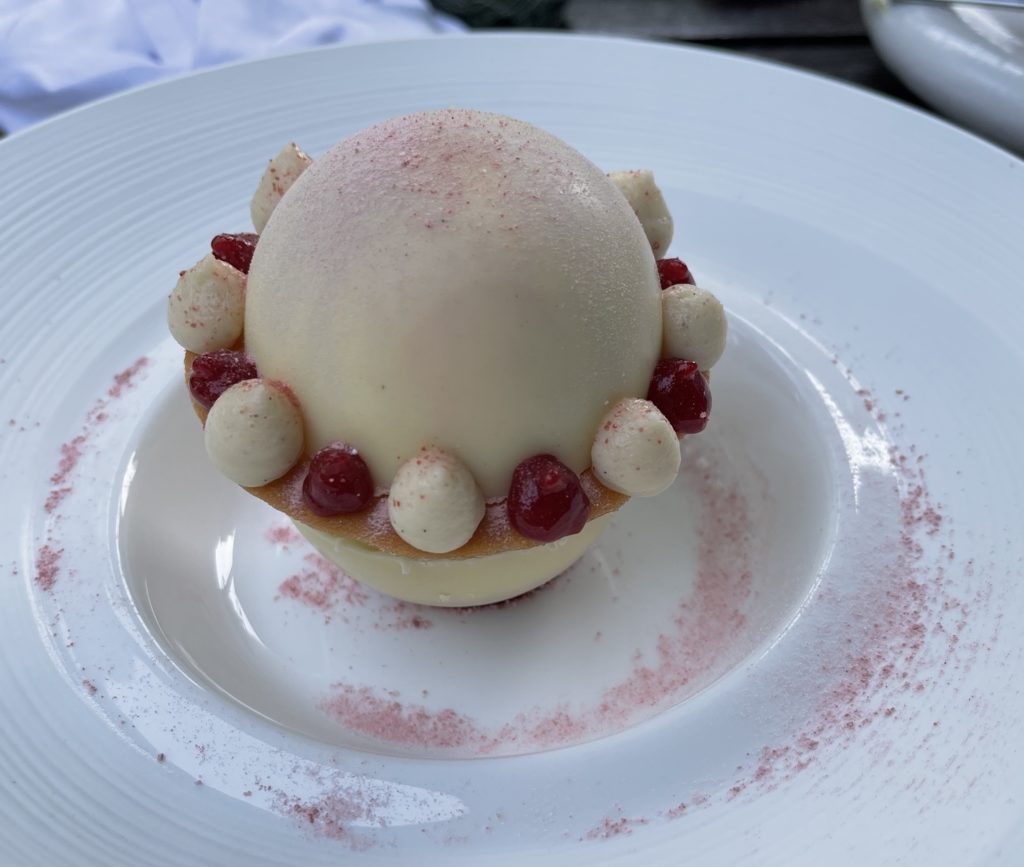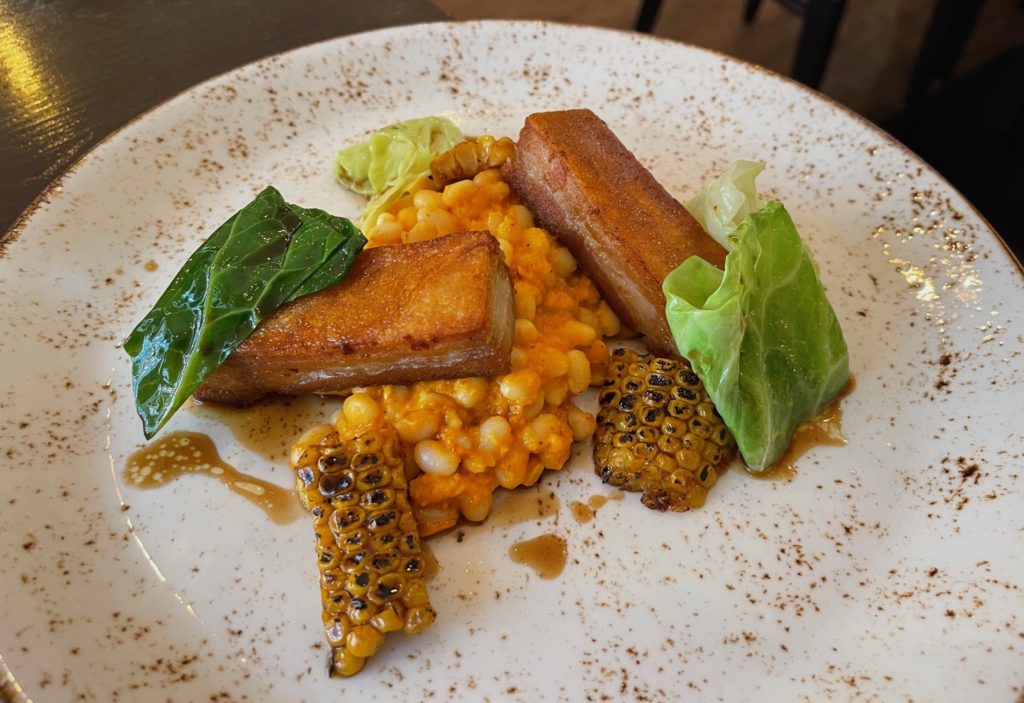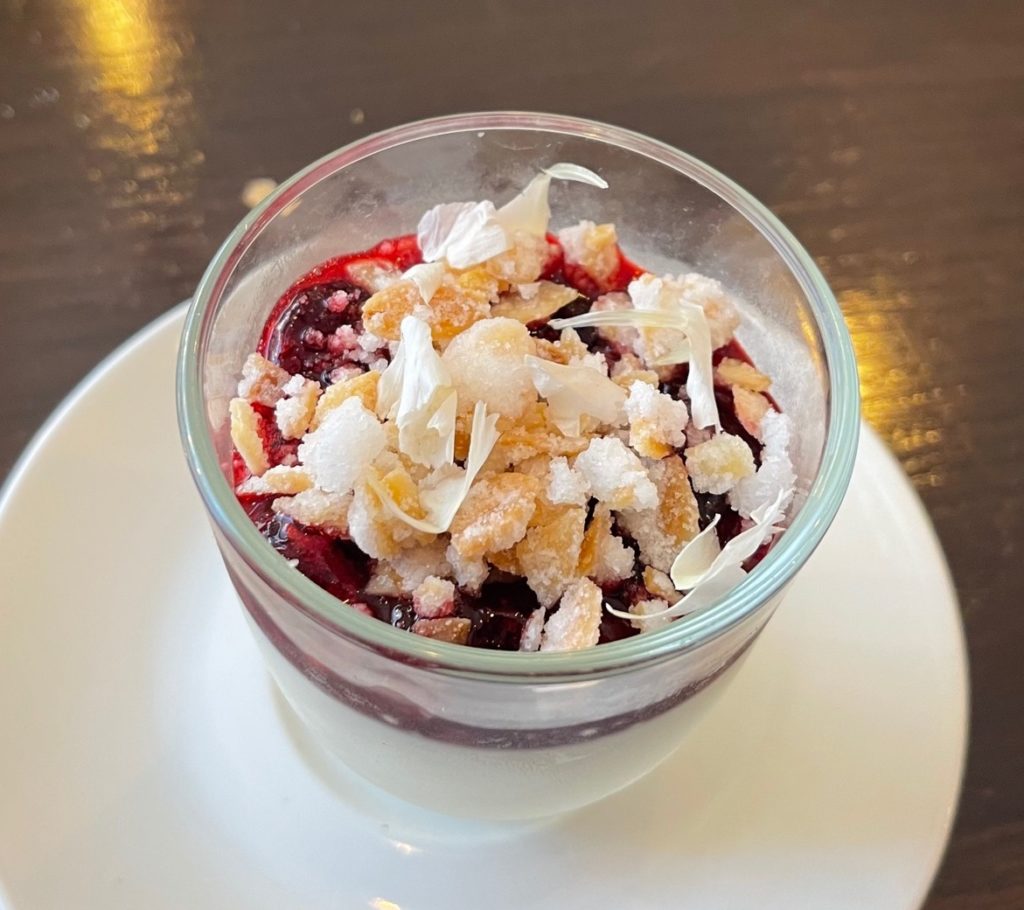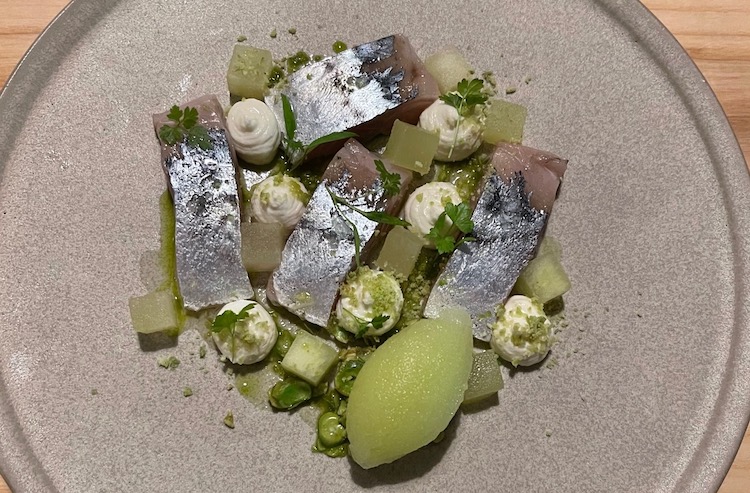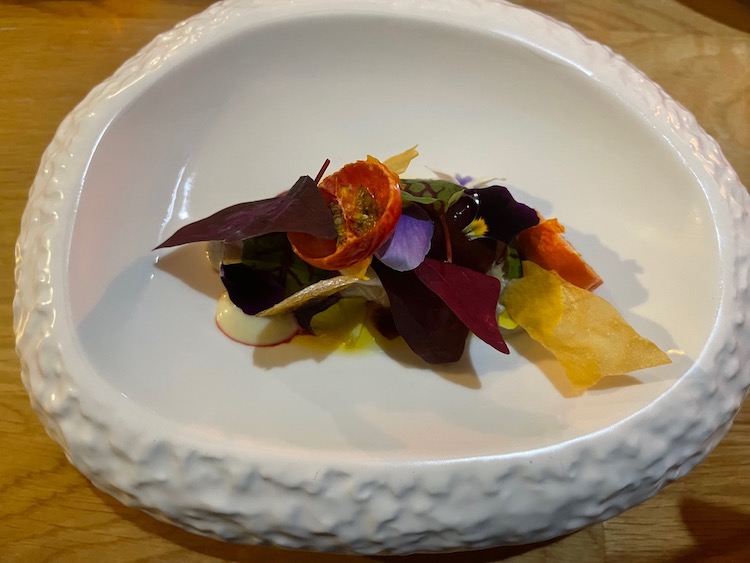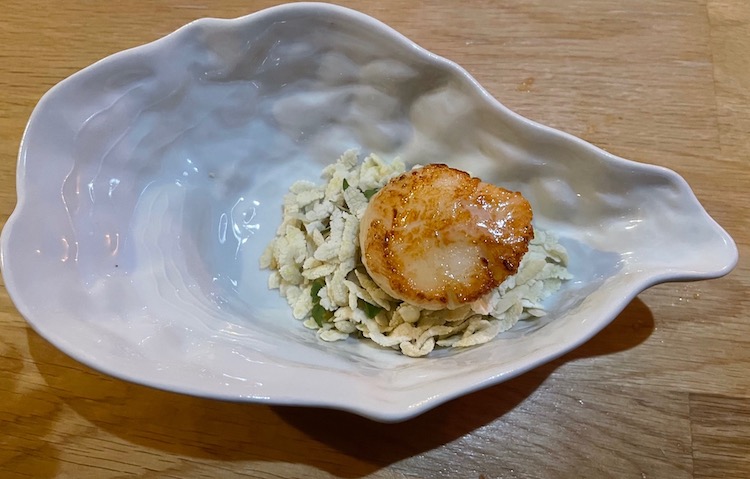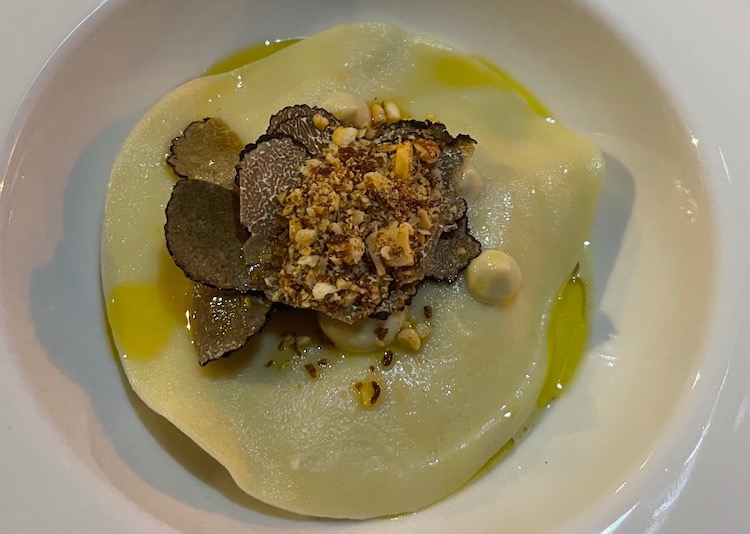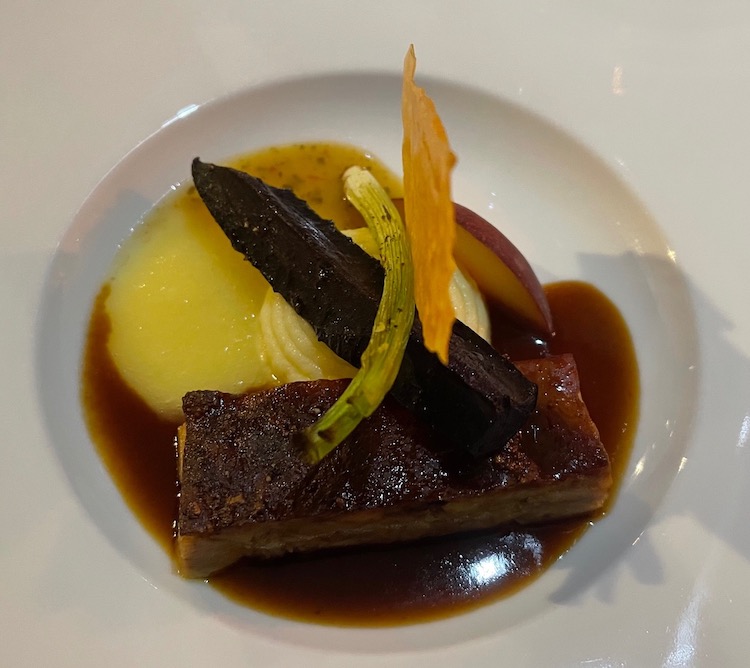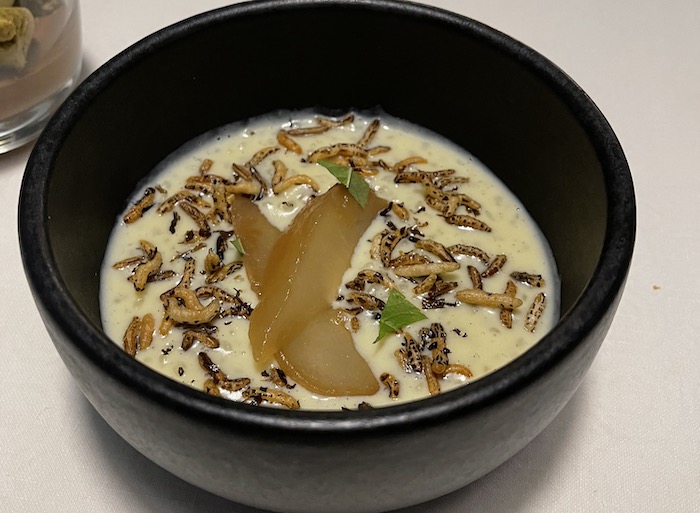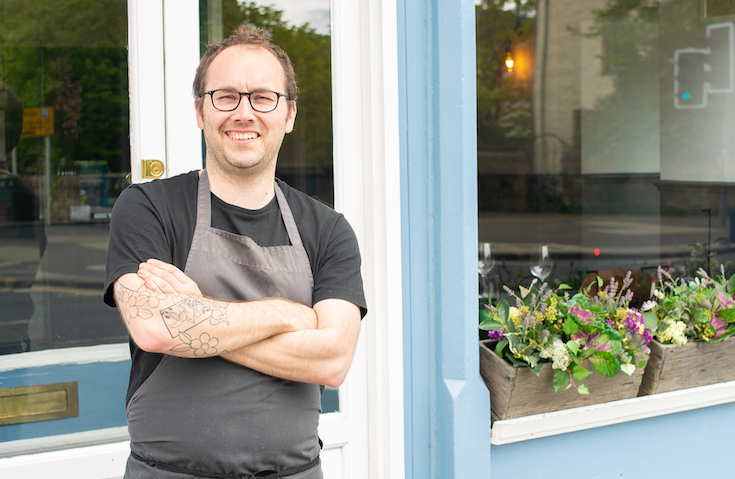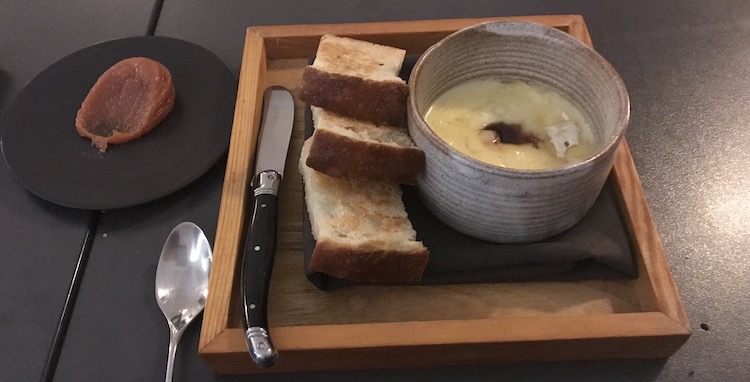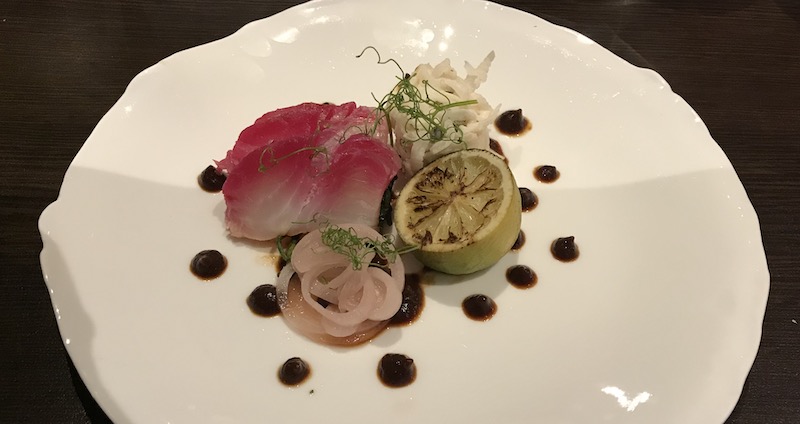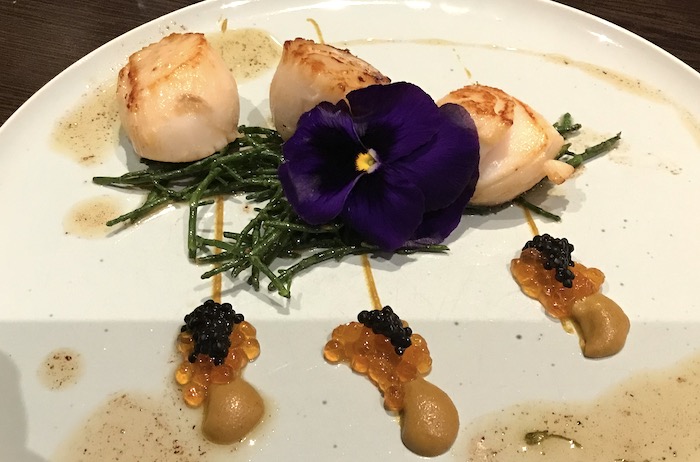David O’Connor and Joe Mercer-Nairne, owners of Medlar, for 15 years the acclaimed restaurant in Chelsea, have opened their second restaurant, Cornus, at 27c Eccleston Place, Belgravia. It is Located on the top floor of the Ice Factory, a repurposed warehouse in a corner of Ecclestone Yards precinct.

Reached through an imposing entrance and its own lift, the “L” shaped dining room is bright and airy. Well-spaced round tables with comfortable designer chairs line the side walls while a line of smaller square ones with banquette seating occupy the middle, giving a capacity of 75+ covers. There is also a private dining room seating 18 to 20 guests. A long marble bar with a quadruple arched drinks display is a major feature, its rounded curves soften the sharp horizontal and vertical lines which dominate the room. The colour scheme – a “mid-century modern palette” – allows everything to work harmoniously, such as the dark of the wood merging into the lush of the velvet curtains. The hanging artwork will reflect the varied colours of the dogwood plant, the non- botanical name for Cornus.

In an otherwise elegant restrained design, the steel air conditioning units and ducts provide an element of industrial chic. Above each unit the vertical glazing of the sawtooth roof provides ample natural light throughout. This is supplemented by well-directed spotlights, feature lights over the bar, and discreet wall lighting. At night, the twinkling lights of the capital’s skyline enter through the large windows.
In future developments, the terrace will also enable al fresco dining and there is potential for a conservatory extension.
Leading the kitchen brigade of eight is executive chef Gary Foulkes. With an impressive CV of over 20 years cooking in Michelin starred restaurants, including a head chef position under Phil Howard at The Square, he finally gained and maintained his own star at Angler restaurant in The City.
Gary’s finely tuned cooking is based on French classical skills partnered by imagination and flair both in the combination of ingredients and cooking methods. Witness, for instance, cod with Scottish girolles, squid and bacon or or tomatoes dressed in cherry juice.
No compromise has been made on the provenance of top quality, largely seasonal ingredients. Scottish langoustines, Devon crab, Loch Duart salmon, native lobster, Landes chicken, Alsace bacon and even N25 Oscietra caviar all feature on the current menu. The use of Hubert Lacoste’s tomatoes, Black Australian truffles, Romero peppers, English raspberries, Amalfi lemons and Sicilian pistachios reflect a similar approach to plant-based produce. Some oriental influences are seen in the use of wasabi, Haas avocado, shiso, fig leaf and finger limes.

The visual simplicity of dishes belies their complexity of conception, the labour intensity of execution, and restraint in the immaculate presentation. Precise cooking and resting of meat and fish dishes maximise their inherent flavour while balance in taste and texture is achieved by complementary garnishes, intense purees and light sauces. Nevertheless, plates are uncluttered, with clean presentation allowing the star of the dish to shine. Vegetarian options are treated with equal care and respect.
A three-course menu with just five options in each course – not including a Cote de Beouf sharing dish – allows the kitchen to deliver at a consistently high level. There is a slight emphasis on shellfish and fish. Prices are realistic given the superb quality of the ingredients, the expertise in transforming them into exquisite cuisine, and the comfort of the newly designed restaurant in a central London location, not to mention the seamless, engaging hospitality for which David O’Connor is renowned. They also compare favourably with similar high end restaurants boasting Michelin starred chefs.
Meals begin with a crisp gougere filled with a strong cheese fondue topped with an ethereal parmesan chiffonade. This amuse-bouche excited the palate without stealing the thunder of the dishes to follow. Sourdough and focaccia bread were both well-crafted.

An outstanding starter featured soft, hand rolled spaghetti topped with a trio of lobster slices and a generous quenelle of N25 Oscietra caviar. It was dressed with a reduced bisque enhanced with lobster coral. The succulence of the crustacean, the umami hit of top-grade caviar – both lifted by the gentle freshness of Amalfi lemon – and the rich viscosity of the bisque made this a sensational tour de force of cookery.
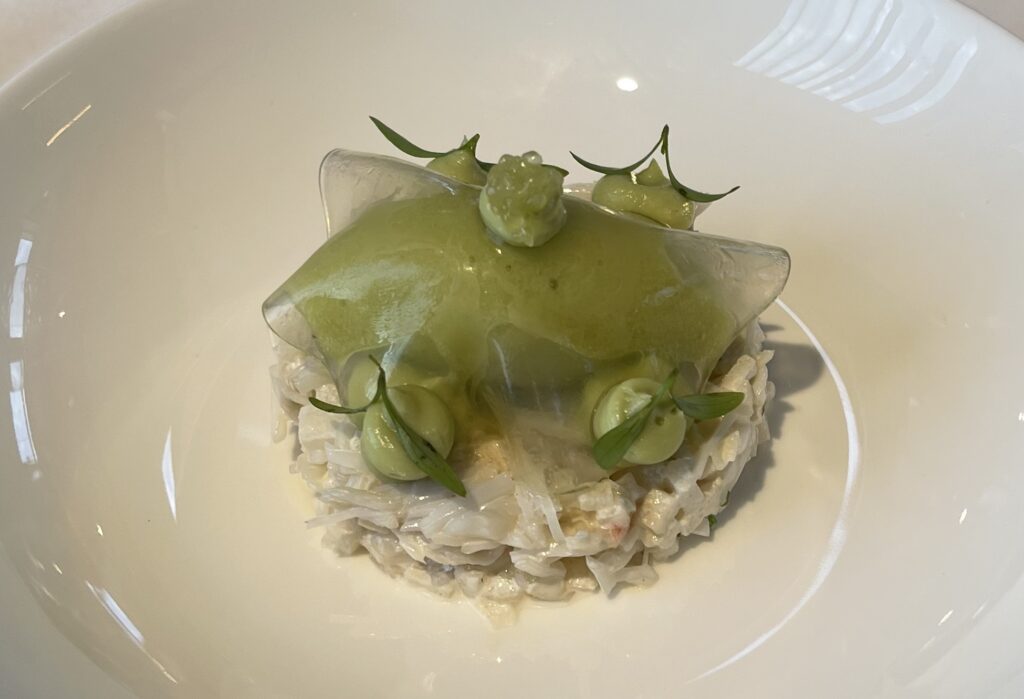
A visually stunning dish of handpicked Devon crab showed the meticulous attention to detail for which the chef is renown. The sweet and slightly briny crab meat was blended with a judicious amount of wasabi foam which enhanced the delicate white flesh. Piped drops of Haas avocado added a contrasting subtle creaminess, while the harmonious combination was lifted by a gel of finger lime decorated with their leaves. This light shellfish starter delighted in its clean, vibrant freshness.

A third starter of Loch Duart Salmon tartare saw the well-seasoned, utterly fresh fish bound by a light oyster cream. The richness was balanced by the gentle acidity of green apple batons and the herbaceous astringency of shiso.
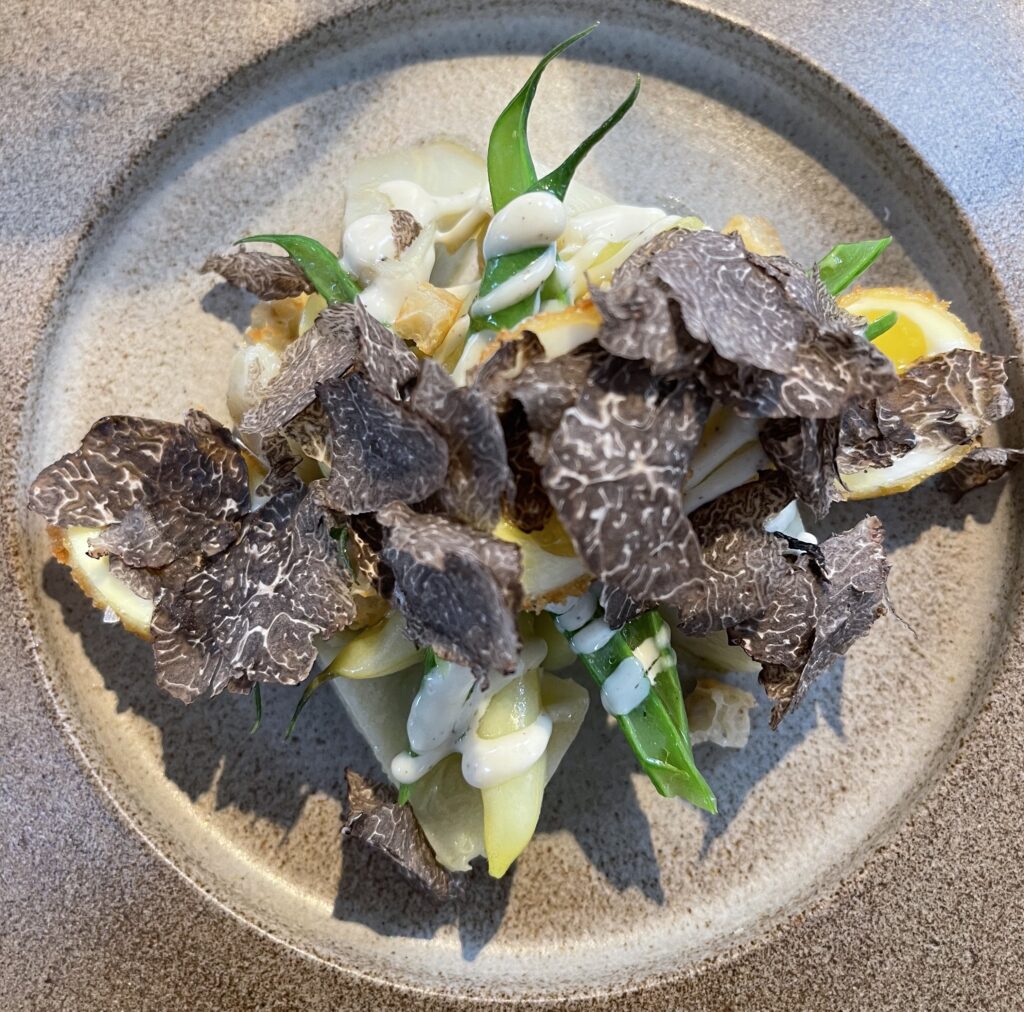
A lightly dressed warm salad of artichokes and summer beans was accurately timed to retain their crisp textures and earthy flavours. Breaded soft yoke quail’s eggs added a skilful contrasting element while the whole dish was finished with a generous scattering of headily fragrant shaved black Australian truffle.
The two fish main courses demonstrated accurate timing in their pan roasting and resting to produce a golden seared crust and soft gleaming white flesh.

The mild taste and firm texture of Roast Wild Halibut allowed it to take on other bolder flavours as shown in the dressing of black olives, semi dried San Marzano tomatoes, parsley, shallots and lime. Lightly cooked ribbons of yellow courgette came as a swirl and in a cannelloni form stuffed with a flavoursome Baldo rice, tomato and herb filling. Parsley puree added a powerful hit to this impressive combination of tastes and textures.

The delicate, buttery flakes of Roast Newlyn Cod testified to its utter freshness. Cauliflower puree added a smooth creaminess. The innovative trio of a persillade of Scottish girolles, seared line caught squid and Alsace bacon gave contrasting robust flavours to balance the gentle sweetness of the fish.

Perhaps the simplest yet the most successful main course showcased Arnaud Tauzin’s acclaimed free range, corn-fed Landes chicken. The well-seasoned roasted breast had burnished skin and firm, juicy full flavoured flesh. Plump, sweet Scottish langoustine tails complemented the savoury flavour of the poultry while sauteed girolles and corn puree added earthy notes and contrasting textures. This combination was adorned with a generous scattering of Black Australian truffle, which made it even more luxurious, and finished with a light roast chicken sauce. This dish showed how expensive, top grade ingredients treated with respect and cooked simply can produce brilliant results.

A main course of Southdown lamb used juicy rump – one of the most flavoursome cuts – and lamb trimmings in a spicy kofte. Paired with sweet pepper piperade and seasoned with fried capers and olives, this accurately timed and judiciously balanced dish of strong tastes celebrated the true flavours of the Mediterranean.
Desserts also maintained the lofty standards of the savoury courses, revealing the refined skills of the pastry section.

A mille-feuille of English raspberries had beautifully crisp, perfectly laminated layers of buttery puff pastry sandwiched with rich lemon verbena cream and topped with raspberry coulis and a velvety smooth baked ice cream using baked raspberries which produce a richer, more rounded flavour.
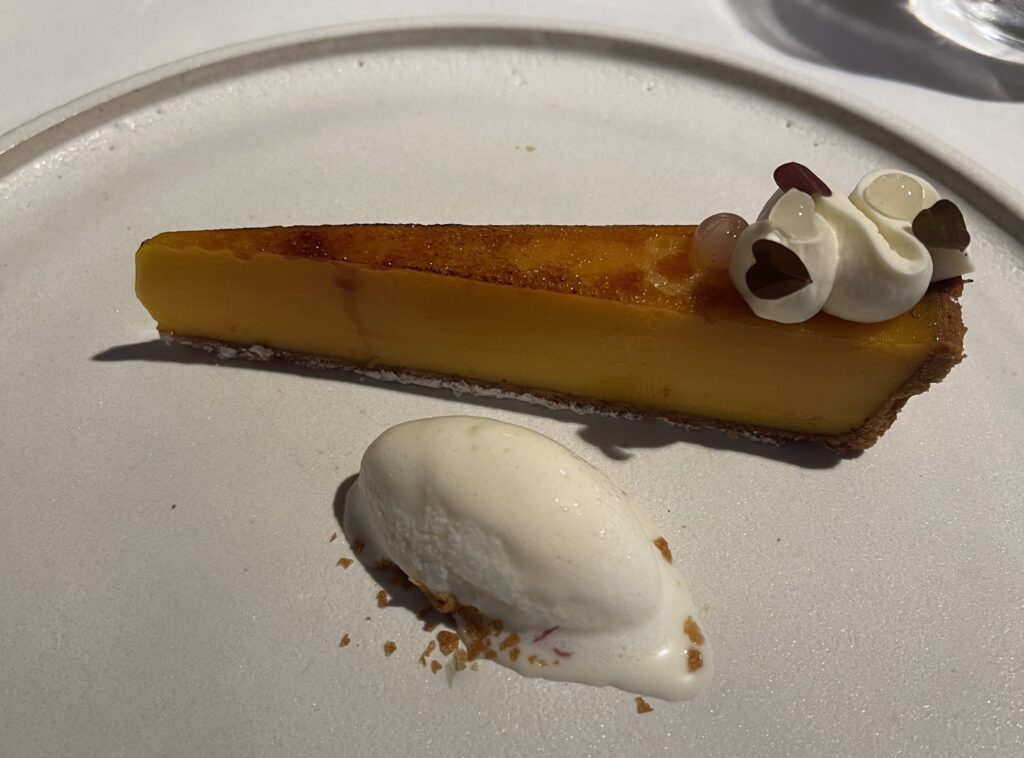
A simpler, but no less accomplished dessert, was a slice of Amalfi lemon tart with crisp pate sucree and a soft, creamy filling with a deeply intense citrus tang. Silky Greek Yogurt ice cream complemented the tart perfectly.
A choice of Difference coffee, a speciality, and two cocktails – Expresso Martini and Clarified coffee Negroni are offered as post dinner drinks
Canapes of apricot and yoghurt macaroons, chocolate and pistachio amaretti, and hazelnut and clotted cream fudge were models of their kind, bringing a sweet conclusion to a highly satisfying meal.
Hospitality at Cornus begins with a welcoming and friendly greeting on arrival. This puts guests at their ease, the relaxed feel being reinforced by the cheerful non uniformed front of house staff. Knowledgeable advice is offered on food and wine. Melania Battison from Medlar has now returned as the engaging, passionate head sommelier, guiding diners through a serious wine list of Old and New World offerings. Attention at tables is efficient, can be anticipatory, but is never intrusive. All this makes for a most pleasant dining experience.
Cornus is an exciting addition to the highly competitive fine dining scene in central London. Given the extensive experience both in the front of house and in the kitchen, it deserves to be successful. Fine Dining Guide wishes David, Gary and their teams continued good fortune and will follow their progress with studied interest.










